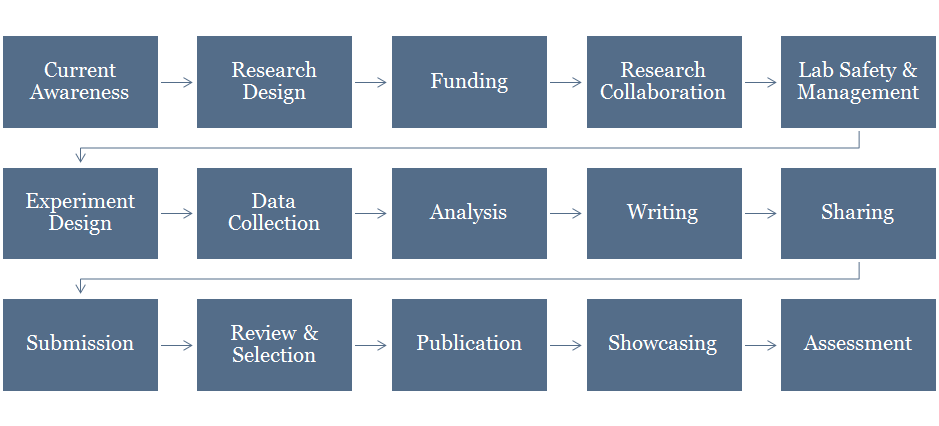What is Researcher Workflow?
Over the past two years, I have been urging that academic information professionals, including librarians and publishers, give greater attention to how they might support a growing share of the researcher workflow. But what is researcher workflow?
The researcher workflow can be defined in a number of ways. For laboratory scientists, it includes research design and funding, moves through data collection and analysis, and takes them to assessment and showcasing. This very rough schematic offers a basic illustration of a certain researcher workflow:

Scholars and in particular the laboratory scientists who work as teams can increase their effectiveness using platforms and systems that support their research workflow. This includes opportunities to enhance their research productivity and the reproducibility of their findings. The open science community has developed as a major proponent of researcher workflow platforms and systems.
Researcher workflow is an area of substantial investment from a variety of investors, including several major scholarly publishers. One key strategic question is the degree of integration investors are pursuing across their products, which can yield a more closed end-to-end integrated platform or various types of more open approaches.
My colleagues and I at Ithaka S+R are watching this area closely. Tomorrow, we will publish a report by Danielle Cooper, Katherine Daniel, and a team of 14 co-authors from seven universities about the research practices of public health scholars. That report will show how workflow–especially for researchers who collaborate across institutional and national borders–presents some significant challenges. As a community, we face critical questions about how universities can best support researcher workflow and what role the library should play in providing sound services and broad strategic alignment.
Pingbacks
Things we read this week (15 December 2017) – BMJ Digital
Workflow Strategy for Those Left Behind: Strategic Context - The Scholarly Kitchen
Workflow Strategy for Those Left Behind: Strategic Options - The Scholarly Kitchen
Workflow Lock-in: A Taxonomy - The Scholarly Kitchen
A New Citation Database Launches Today: Digital Science’s Dimensions - The Scholarly Kitchen
Why just 2.5%? – IO: In The Open
Guest Post - Pictures Worth a Thousand Words? On Visualizations of Scholarly Workflow - The Scholarly Kitchen
Will Libraries Help Publishers Prop Up the Value of the Big Deal? - The Scholarly Kitchen
Comments
Thank you for addressing this interesting and important topic. It is strongly recommended to also make a connection with the research data lifecycle - handeling data in a proper way - during and after the research process. This means at least also including data storage in the Research workflow.
Proper Research Data Management stimulates the reuse of data (FAIR data where possible), reproducibility of research and it is a next step to rewarding data intensive research, in the broader context of open science.
Research libraries do play an instrumental role in this.
Looking forward to reading your follow up blog.